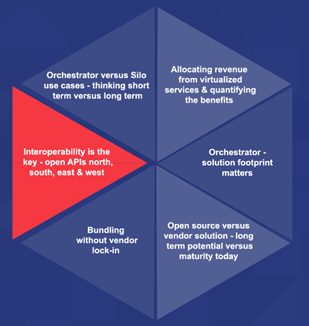SD-WAN FEATURED ARTICLE
Key Considerations to Build a Business Case for Service & Network Orchestration

In pursuit of a successful network transformation, one of the important aspects is to identify and define the areas that are most relevant to the Digital Service Providers (DSPs) set goals. One such area that demands a thorough business case and decisioning is service & network orchestrator. The service & network orchestrator is a central component of the network functions virtualization (NFV) based solution, which enables orchestration and automated provisioning of resources across multiple network domains, data centers as well as physical legacy network.
Today, the decisioning on virtual network functions (VNFs) such as SD-WAN (software-defined wide area network), virtual evolved packet core (vEPC), virtual converged cable access platform (vCCAP), carrier ethernet (CE) 3.0, and security functions such as unified threat management (UTM) is relatively straight forward because of the aligned business goals & KPIs. In some cases, the decisions are also driven based on incumbent vendor roadmap or end-of-life of current network appliances.
Among all the network functions that demand a thorough business case, service and network orchestrator stands apart as the overarching component applicable across all the network use cases – hence building a business case is relatively complicated. The value proposition including the related quantitative and qualitative revenue and savings are buried across the use cases at all three states (current, transition, and target) of the network and IT ecosystem architecture – and hence the need for defining the related business case.
This article brings out 6 broad areas across network & IT, that Digital Service Providers (DSPs) must evaluate to arrive at the related ROI (return on investment) and TCO (total cost of ownership) for service & network orchestrator.

Allocating revenue from virtualized services & quantifying the benefit
Identify and allocate share of revenue for each service and network functions (SD-WAN & uCPE, network security functions, enterprise connectiivty services and so on). Quantifying the benefits is key. For instance, we have seen with our customers and from wider industry statistics that time to roll out new services has reduced from 12-18 months to 2-3 months post orchestrator implementation. Likewise, service delivery time has reduced from 2-3 months to a mere few days for enterprise and wholesale customers. These benefits are primarily driven via the orchestrator and related automation, including the north-bound and south-bound integrations to enable the zero-touch provisioning. Hence, it is important to quantify the related benefits as part of the orchestrator business case.
Orchestrator solution footprint matters
Vendor orchestrator pricing includes three components, license fees, ASM (News - Alert) (annual support and maintenance cost), and professional services. The value a DSP can derive from capabilities like multi-domain support, hybrid PNF & VNF support, service & networking provisioning, business process management, product catalog, dynamic inventory management and policy management.
Saving from the phased replacement of one or more existing OSS/IT applications via orchestrator will also follow. The orchestrator can be extended to provision legacy physical network elements and can be leveraged across geographies and network domains (core, transport, access, etc). Simplifying and automating related business processes as part of the overall network transformation will reduce the overall service delivery & provisioning cycle.
Open source vs Vendor solution
The decision between an open-source orchestrator solution and a vendor orchestrator solution is an important consideration. Initial cost like the license cost for vendor orchestrator is higher. On the other hand for open source orchestrator, we do not carry a significant initial cost but it’s support & operational cost is higher and will have a higher dependency on system integrators. However, the higher support & operational cost reduces as the open-source solution matures and opens up to a wider footprint in future depending on the support from the open-source contributing community.
Build without vendor lock-in
Typically, the orchestrator vendor will also provide one or more add-on capabilities like SDN controller, NFV orchestrator (NFVO) and service assurance (closed-loop assurance). This will reduce the overall license cost and minimize integration cost (professional services). To avoid lock-in, one must verify if the vendor solution architecture is modular, microservices-based, leverages standard open APIs and supports VMs/containers.
Interoperability is the key
Alongside the implementation of professional service (PS) cost, the integration cost is also a key cost contributor. Multiple integration scope emerges due an orchestrator. For instance,
- Integration with northbound OSS monolithic, or OSS 2.0 applications
- Integration with third-party NFVO, SDN Controllers, NMS/EMS, data center, directly with network elements based on planned use cases & legacy network
- Integration with service assurance systems and AI/ML frameworks for closed-loop assurance
- Intercarrier services related integration
For some orchestrators, the PS cost is based on implementation use cases like SD-WAN, vEPC, vCCAP, rather than based on number of integration/APIs.
Few aspects that will reduce the PS cost are reusability based on past implementations, and support for standard APIs such as MEF (News - Alert) LSO, which covers the wider solution stack and TMF APIs for northbound OSS/IT integrations. When considering an orchestrator vendor, it is important to verify if they have implemented use cases that are relevant to the business case. This will not only reduce the PS cost, but also increase the chances of implementing successful use cases in defined timeline & budget.
Orchestrator vs Silo use cases
Question the very existence of the orchestrator in contrast to the siloed use cases. Long term cost of not having an orchestrator can be the higher cost for managing siloed use cases (e.g. vEPC, vIMS, vCCAP, CE). Other pitfalls include the inability to leverage or streamline processes and network virtualization across use cases, ecosystem complexity, future upgrade challenges, limited automation benefits, and so on.
On the other hand, by not having orchestrator, we may gain short term by avoiding costs like license, PS (professional service cost) and ASM (annual support and maintenance cost). We may also gain by having a faster go-live of the initial use cases such as SD-WAN where most of the related vendors already include basic orchestration capabilities.
Summary
The service & network orchestrator is the key component of the overall SDN/NFV ecosystem solution and is the enabler for zero-touch provisioning and intent-based orchestration. The process of evaluating an orchestrator and building the related business case requires special attention because of its complexity. It has dependency across the board with OSS/IT applications, multiple network domains, legacy network appliances, evolving virtual appliances, AI/ML based closed-loop assurance systems and so on.
The key open-source solutions evaluated include ONAP and OSM. The sample vendor solutions (along with RFI/RFQ) for strategic customer implementations include Amdocs (News - Alert), Ciena, Cisco, Ericsson, HPE, Huwaei, Juniper, Nokia, and Oracle. The recommendation is an assimilation from multiple SDN/NDFV consulting and implementation engagements.
About the Author: Hema Kadia heads SDN-NFV, Strategy and Practice at Prodapt, defining solutions & service offerings, and addressing the business needs across the digital and network transformation journey. She has over 20 years of experience, with successful achievements in the IT, telecommunications and media industries.
Edited by Maurice Nagle
